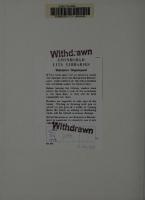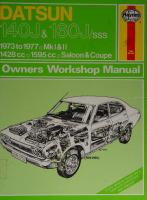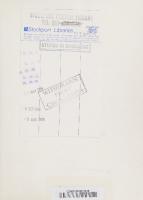Haynes Morris Ital 1.7 & 2.0 1980 to 1984 Owners Workshop Manual 1850100640, 9781850100645
“198 pages : 28 cm Includes index”.
124 10
English Pages 204 Year 1984
Recommend Papers
File loading please wait...
Citation preview
uotsl Om com olor!
Y
THIN WIRE Ms
ALTERNATOR
SMALL TERMINAL
WIRE
~ LOOM H/34/7
H/34/19
Fig. 10.20 The correct way to connect a capacitor to the alternator
(Sec 40)
Fig. 10.21 The capacitor must be connected to the ignition side of the coil (Sec 40)
DISTRIBUTOR INTERNAL RESISTOR
INTERNAL RESISTOR
TWIN SCREW-IN
SCREW IN FOR HT LEAD HISLIG
Fig. 10.22 Ignition HT lead suppressors (Sec 40)
146 Chapter 10 Electrical system n a e i
ean
0.25uf—0.5uf
whe OO on a O FUSE
SWITCH (1F FITTED)
MOTOR
H(34Z0 )
Fig. 10.23 Correct method of suppressing electric motors (Sec 40) OPTIONAL CAPACITOR (GIVES MARGINAL IMPROVEMENT)
0.25uf—O.Suf af
a
.
< HID42
LIVE
GAUGE FUEL/TEMPERATURE
So
Fig. 10.24 Method of suppressing gauges and their control units (Sec 40)
KEEP THIS LEAD AS SHORT AS POSSIBLE IN LINE
CHOKE
13422
(SEE TEXT)
LIVE
Fig. 10.25 An ‘in-line’ choke should be fitted with the live supply lead as close to the unit as possible (Sec 40)
At this stage it is advisable to check that the radio is well earthed, also the aerial, and to see that the aerial plug is pushed well into the set and that the radio is properly trimmed (see preceding Section). In addition, check that the wire which supplies the power to the set is as short as possible. At this stage it is a good idea to check that the fuse is of the correct rating. For most sets this will be about 1 to 2 amps. At this point, the more usual causes of interference have been suppressed. If the problem still exists, a look at the cause of interference may help to pinpoint the component generating the stray electrical discharges. The radio picks up electromagnetic waves in the air. Some are made by regular broadcasters and some, which we do not want, are made by the car itself. The home made signals are produced by stray electrical discharges floating around in the car. Common producers of these signals are electrical motors, ie the windscreen wipers, electric screen washers, electric window winders, heater fan or an electric aerial, if fitted. Other sources of interference are flashing turn signals and instruments. The remedy for these cases is shown in Fig. 10.23 for an electric motor whose interference is not too bad and Fig. 10.24 for instrument suppression. Turn signals are not normally suppressed. In recent years, radio manufacturers
have included in the live line of the
radio, in addition to the fuse, an in-line choke. If your circuit lacks one of these, put one in as shown in Fig. 10.25. All the foregoing components are available from radio stores or accessory stores. If you have an electric clock fitted, this should be suppressed by connecting a 0.5 mfd capacitor directly across it as
shown for a motor in Fig. 10.23. lf after all this you are still experiencing
assess
how
bad it is, for the human
radio interference, first
ear can filter out unobtrusive
unwanted noises quite easily. But if you eradicating the noise, then continue.
are
still adamant
about
As a first step, a few experts seem to favour a screen between the radio and the engine. This is OK as far as it goes, literally! The whole set is screened anyway and if interference can get past that then a small piece of aluminium is not going to stop it. A more sensible way of screening is to discover if interference is coming down the wires. First, take the live lead; interference can get
between the set and the choke (hence the reason for keeping the wires short). One remedy here is to screen the wire and this is done by buying screened wire and fitting that. The loudspeaker lead could be screened also to prevent pick-up getting back to the radio although this is unlikely. Without doubt, the worst source of radio interference comes from the ignition HT leads, even if they have been suppressed. The ideal way of suppressing these is to slide screening tubes over the leads themselves. As this is impractical, we can place an aluminium shield over the majority of the lead areas. In a vee or twin-cam engine this is relatively easy but for a straight engine, the results are not
particularly good. Now for the really impossible cases, here are a few tips to try out. Where metal comes into contact with metal, an electrical disturbance is caused which is why good clean connections are essential. To remove
interference
due to overlapping
or butting panels, you must
bridge the join with a wide braided earth strap (like that from the frame to the engine/transmission). The most common moving parts that could create noise and should be strapped are, in order of importance:
(a)
Silencer to frame
(b)
Exhaust pipe to engine block and frame
(c) (d)
Air cleaner to frame Front and rear bumpers to frame
fe)
Steering column
(f)
Bonnet and boot lids to frame
to frame
Chapter 10 SSS
=
nn
Electrical system es ses
These faults are most pronounced when the engine is idling or labouring. under load. Although the moving parts are already connected with nuts, bolts, etc, these do tend to rust and corrode, this creating a high resistance interference source. If you have a ragged sounding pulse when mobile, this could be wheel or tyre static. This can be cured by buying. some anti-static powder and sprinkling inside the tyres. If the interference takes the shape of a high pitched screechiny noise that changes its note when the car is in motion and only comes now and then, this could be related to the aerial, especially if it is of the telescopic or whip type. This source can be cured quite simply by pushing a small rubber ball on top of the aerial as this breaks the electric field before it can form; but it would be much better to buy yourself a new aerial of a reputable brand. If, on the other hand, you are getting a loud rushing sound every time you brake, then this Is brake static. This effect is most prominent on hot dry days and is cured
41
en
ens
sn
se
147 eee ee
only by fitting a special kit, which is quite expensive. In. conclusion, it is pointed out that it is relatively easy, and therefore cheap, to eliminate 95 per cent of all noise, but to eliminate the final 5 per cent is time and money consuming. It is up to the individual to decide if it is worth it. Please remember, also, that you cannot get a concert hall performance out of a cheap radio. Finally, players and eight track players are not usually affected by
car noise but in a very bad case, the best remedies are the first three suggestions plus using a 3 to 5 amp choke in the live line, and in incurable cases, screening the live and speaker wires. Note: /f your car is fitted with electronic ignition, then it is not recommended that either the spark plug resistors or the ignition coil capacitor be fitted as these may damage the system. Most electronic ignition units have built in suppression and should, therefore, not cause interference.
Fault diagnosis — electrical system
Symptom
Reason(s)
No voltage at starter motor
Battery discharged Battery defective internally Battery terminal leads loose or earth lead not securely body Loose or broken connections in starter motor circuit Starter motor switch or solenoid faulty
attached
Voltage at starter motor: faulty motor
Starter motor pinion jammed in mesh with flywheel gear ring Starter brushes badly worn, sticking, or brush wires loose Commutator dirty, worn or burnt Starter motor armature faulty Field coils earthed
Electrical defects
Battery in discharged condition ; Starter brushes badly worn, sticking, or brush wires loose Loose wires in starter motor circuit
Mechanical
Pinion or flywheel gear teeth broken or worn
damage
Lack of attention or mechanical
Wear
damage
or damage
Pinion or flywheel gear teeth broken or worn Starter motor retaining bolts loose Battery defective internally Electrolye level too low or electrolyte too weak due to leakage Plate separators no longer fully effective Battery plates severely sulphated
Insufficient current flow to keep battery charged
Fanbelt slipping Battery terminal connections loose or corroded Alternator not charging properly Short in lighting circuit causing continual battery drain Regulator unit not working correctly
Alternator not charging*
Fanbelt loose and slipping, or broken Brushes worn, sticking, broken or dirty Brush springs weak or broken
* /f all appears to be well but the alternator is still not charging, take the car to an automobile electrician for checking of the alternator and regulator. Battery will not hold charge for more than a few days
Battery defective internally Electrolyte level too low or electrolyte too weak due to leakage Plate separators no longer fully effective Battery plates severely sulphated
Fan/alternator belt slipping Battery terminal connections loose or corroded Alternator not charging properly Short in lighting circuit causing continual battery drain Regulator unit not working correctly
Ignition light fails to go out, battery runs flat in a few days
Fanbelt loose and slipping or broken Alternator faulty
to
Chapter
148
10
Electrical system
ee Reason(s)
Symptom
SS
III
08
Failure of individual electrical equipment to function correctly is dealt with alphabetically, below Fuel gauge
gives no reading
. Fuel tank empty!
Electric cable between tank sender unit and gauge disconnected
Fuel gauge
case not earthed
Fuel gauge supply cable interrupted Fuel gauge
unit broken
tank unit and gauge earthed
Fuel gauge registers full all the time
Electric cable between
Horn emits intermittent or unsatisfactory noise
Cable connections loose Horn incorrectly adjusted
Horn fails to operate
Blown fuse Cable or cable connection Horn has an internal fault
Horn operates all the time
Horn push either earthed or stuck down Horn cable to horn push earthed
Instrument Lights come
readings erratic on but fade out
Lights do not come
on
loose, broken or disconnected
Voltage stabiliser faulty If engine not running battery discharged If engine not running, battery discharged Light bulb filament burnt out or bulbs broken Wire connections loose, disconnected or broken Light switch shorting or otherwise faulty
Lights give very poor illumination
Lamp glasses dirty Reflector tarnished or dirty Lamps badly out of adjustment Incorrect bulb with too low waggage fitted Exisiting bulbs old and badly discoloured
Wiper motor fails to work
Blown fuse Wire connections loose, disconnected Brushes badly worn Armature worn or faulty Field coils faulty
Wiper motor works but wiper blades remain static
Linkage disengaged or faulty Drive spindle damaged or worn Wiper motor gearbox parts badly worn
Wiper motor works slowly and takes little current
Brushes badly worn Commutator dirty, greasy or burnt Armature badly worn or faulty
Wiper motor works very slowly and takes excessive current
Commutator dirty, greasy or burnt Drive to spindles too bent or unlubricated Drive spindle binding or damaged Armature bearings dry or unaligned Armature badly worn or faulty
or broken
149
See overleaf for Wiring Diagrams
Key to wiring diagram for Saloon and Estate Note: Wot a// items listed are fitted to all models
1
Battery
2 3
Starter motor Starter solenoid
4 5
Fusebox Line fuse
6
Ignition/starter switch
7
Not applicable
8 9 10 11
172 73 14 15 76 17 718 19 20
49 50 51 52 53, 54 55
(Van and Pick-up) Ignition coil Ignition warning lamp Distributor Alternator Horn(s) Horn switch Ballast resistor Lighting switch Headlamp Main beam Headlamp Headlamp Headlamp
main beam warning lamp dip switch
Choke warning switch
Choke warning lamp Oil pressure switch Oil pressure warning
56
lamp ; Water temperature
57
gauge Water temperature gauge
differential switch
63 Brake failure switch and warning lamp
64 Dashpot heater 65 Windscreen wash/wipe switch
66 Windscreen wiper motor 67 Windscreen washer motor 68 Rear window demister switch
69 Rear window demister
switch unit switch warning lamp indicator indicator
element
70 Rear window demister warning lamp Heater switch Heater motor Heater control illumination Selector illumination
33 Rear RH indicator 34 Rear LH indicator 35 Indicator repeater lamp 36 Hazard warning lamp 37 Hazard warning switch 38 Hazard warning unit 39 Reversing lamp 40 Reversing lamp switch 41 Rear fog lamp 42 Rear fog lamp switch 43 Rear fog lamp warning 44 45 46 47 48
Fuel pump (hot climate)
sender unit
dip beam flasher switch Sidelamp (RH) Sidelamp (LH) Rear lamp (RH) Rear lamp (LH)
Stoplamp Indicator Indicator Indicator Front RH Front LH
Induction heater
58 Tachometer 59 Clock 60 Handbrake warning switch 67 Handbrake warning lamp 62 Brake pressure
21 22 23 24 25 Number plate lamp(s) 26 Stoplamp(s) 27 28 29 30 31 32
Fuel gauge sender unit
(automatic transmission) /nterior lamp(s) Interior lamp switch /nterior lamp door
switch(es) Boot lamp
Boot lamp switch Cigar lighter
Cigar lighter
lamp Voltage stabilizer Panel lamps
iMumination
Radio Glovebox lamp Glovebox lamp switch
Switch illumination Blocking diode Fuel gauge
Note: Where a cable is shown coded by two colours, the first indicates the main colour and the second indicates the tracer colour
Colour code Black Red
BK RD YWw BL BR SL LGR GR PI OR PU WH
Yellow
Blue Brown Slate
Light green Green Pink Orange Purple White
BL/WH BL/WH
151
=
BL/WH
Re Soin
i 16
419 d19
Lh ele
0
a
ee BK
K
BK
BK
3
4
BL{RO BIRD
fg @-ROIBK
BkK-h
ee
BK i
‘ BK
ee 7
|
Ll Wie | Pinte
PUIWH
—-PU/WH
PU/WH:
ae Pu
GR/LGR
_
15016s
i a
i
RD/BK
C29 0 fo)
2
RD/BK:
ard RD/
WH/BK
ee
: RD/BK:
a
en
LoRIWH wa
Moo}
:
iit PU/OR—( >< (40)-BR
sperm
ce
Saas
i
@GRIBR
GRY | 7s,
GR/BR
NOTE { PBK
GR/BR
GRIER-D 1
JHEBK-O-L9
GR
Fo.
iponomeo- Gms
oe
Ra= ston FAI
:
GR/PU
ee
GRIRD
piela |
| too
47
WH
47 PT eriwn
2
de
30
GR/LGR |
FYLeach scared or omo Lo cn (eee
® ®
(Siete
easSaree? pie:
ry
cae
NOTES
1. SALOON MODELS ONLY
a
—0 — corr
GR/LGR
spon-0xo o>camo pono
RD/BK of]
a
ro Q
WGR/PISO
f 29
LGR/BR
we
fe3}
2. NOT PRINTED CIRCUIT ON ESTATE MODELS.
O
Fig. 10.26 Wiring diagram — Saloon and Estate models
a
37 is
152
m
| ater
c ?
BR/LGR
Rg
| R/LGR eae
| BR/LGR
ariiGR-@——— | ee bee
| eat
H.12170
Fig. 10.27 Tailgate wash/wipe circuit — Estate models 7
3
Wash/wipe switch
2
Fuse No 7
iW
—@——_ WH/R
WH/R
Wiper motor
4
Washer motor
cehelen WH/R
WH/R
GR/BR
2
| or
oSo—cripr
5
l_ @ or-@>










